III. Tarzan And The Ant Men
...since all life is trouble, the only thing is to
achieve a position where we may select varieties...
Nero Wolfe as reported by Rex Stout
Prologue
The story of the Ant Men is one of
the more charming idylls in the oeuvre. The story is actually one
novella in a trilogy of stories under the title
Tarzan And The Ant Men.
When you subtract the framing story, Alalusland and the Miranda episodes
you have barely a hundred pages in a hundred and eighty-three page volume.
Burroughs writes in such a condensed
but vivid manner that, perhaps, the stories expand in the mind creating
individual variations that may be shared by no one but oneself but which
are amplified in each mind in endless variations. In other words
these are very nearly interactive stories. A lot depends on what
you bring to the stories.
In this novella Burroughs presents
virtual dissertations on Science and the nature of life, the income tax,
prohibition, the nature of war and peace, Women's Suffrage and religious
matters. I'm sure there are others I'm missing at the moment.
There may even be a discussion of Einstein's Relativity but it seems so
improbable that I may be over reaching and yet the traces can be seen.
And still Burroughs makes the
narrative flow. He may only handle the occasional religious or political
theme in a highly fictionalized manner but it's smooth; there are no gaps
or lacunas. This is fairly amazing in a novel with three separate
themes written over only five months under the most stressful personal
conditions. One wonders how he could do it.
The story centers on the Sixteenth,
Eighteenth and Nineteenth Amendments to the Constitution. It appears
to be heavily influenced by events of the Harding Administration including
the Naval Disarmament Conference of 1922. Disarmament will also appear
in 1931's
Tarzan The Invincible.
As a kid I picked up on the allusions
to Prohibition and the Income Tax. I can't recapture what I found
so profound about the slave quarries but those episodes overwhelmed my
mind as a youth.
Perhaps I associated the incidents
with my own situation on the conscious level and the Anima and Animus on
the subconscious level.
I find the story as exhilarating
at my age today as I did then.
1.
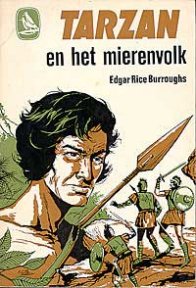 The Ant people are a very militaristic people always prepared for war.
Their military bearing and ardor when Tarzan first encounters them battling
an Alalus woman attracts him to them. As he removes the Alalus woman
from the battle the Ant Men accept him as a comrade in arms. Having
no particular love for the Alalus lad Tarzan abandons him loping off after
the Ant Men.
The Ant people are a very militaristic people always prepared for war.
Their military bearing and ardor when Tarzan first encounters them battling
an Alalus woman attracts him to them. As he removes the Alalus woman
from the battle the Ant Men accept him as a comrade in arms. Having
no particular love for the Alalus lad Tarzan abandons him loping off after
the Ant Men.
For those who have read the corpus
it should be clear that Burroughs considers war the natural state of mankind.
He doesn't actually believe peace will ever be possible. Judging
solely from events since 1923 his opinion would seem to be vindicated.
He himself witnessed the two most destructive wars in history as well as
several of the Indian Wars of the nineteenth, the Boer etc. I have
vague memories of WWII but my mind has not been conditioned by them or
any of the subsequent conflicts which show no sign of ending. Like
Burroughs I see conflict as the natural state of mankind. As Nero
Wolfe said, settle in and pick your favorites. ERB's Beyond
The Farthest Star of 1940 before the shooting started posits a world
in which war never ends, its is a normal state of affairs. Not too
different from our own reality in which wars are being waged everywhere
on the planet.
A probable cause of ERB's
distaste for the 'peaceniks' was the Washington Naval Disarmament Conference
of November 11, 1921 through February 6, 1922. The purpose of the
Conference was to limit naval armaments of the five great naval powers.
One intent was to head off the growing friction in the Pacific between
Japan and the Western powers.
One can gauge the success of
the agreements by the results. To Burroughs, as to any reasonable
person, the results were predictable. Any such discussions between belligerents
may always be characterized as expedients to deceive. Japan went
right ahead with their plans disregarding the 'Spirit Of Locarno' of 1925,
another disarmament fiasco as well as further disarmament conferences in
the thirties even as the country launched their offensive against China.
Perhaps ERB by getting his two
cents worth in hoped to instill reason into the discussion. If so,
he had no chance of success. The spirit of the age -- the Zeitgeist
-- embraced the fantasy of agreements which were never meant to be kept.
In our Zeitgeist of multicultural harmony the same is true. There
won't be any multicultural harmony no matter how hard everyone talks it.
Any apparent agreements are merely timeserving and won't be kept.
As Burroughs says here, accept the facts, and be prepared. As he
knew that defensive wars could not be won he believed a good offense is
the best defense. We should do the same but as he couldn't affect
the Zeitgeist of his period I doubt that there is anyone to listen or act
on the voice of reason today.
Apart from his times Burroughs
was of a military turn of mind. He had been entranced by the Army
ever since his days at the Michigan Military Academy. His descriptions
here are intriguing. The world of the Ant Men, like Beyond The
Farthest Star, is organized around the concept of perpetual war.
Each of the Ant Men cities is perpetually attacking one or the other in
the hope of obtaining slaves on which the Ant Men economy is based.
Or else capturing Princesses into the royal house.
ERB must have been reading works
on Totemism and Exogamy, either books or magazine articles because he gives
a fairly detailed account of the benefits of Exogamy. Exogamy is,
of course, marrying outside the group. In fact, one of the purposes
of capturing slaves is as breeding stock. It goes without saying
that Exogamy is a form of Eugenics. That horrid word again.
At some time in the past the
Trohanadalmakusians, among which Tarzan is, had become effete due to inbreeding.
In the state of perpetual warfare they got wiped. The reasons for
losing weren't due to strategy or weaponry but because the invaders had
greater bodily vitality through the exogamous practice of interbreeding
with slaves.
Being more rational than people
nowadays the practice of exogamy was introduced and the people were now
as vital as anyone else. Problem solved.
Now, according to Burroughs,
there are two types of armies. The one is the rough and ready outfit
that puts all its effort into efficiency like the Trohanadalmakusians,
and the army that puts its effort into showy uniforms and fancy maneuvers
such as the Veltopismakusians among whom Tarzan become a slave.
The Big Guy witnessed a military
execution which greatly impressed him. Lines of warriors faced each
other atop their diadets, or mounts, the Royal Antelope, smallest of all
the antelope breeds, then charged directly at each other. The antelope
don't run per se but take eight to twelve foot bounds so just as it looked
as though the lines were about to crash into each other one line soared
over the top of the other. Tarzan was duly impressed but as he noted,
such showy maneuvers don't win battles. That didn't explain why he
was captured but that was his opinion. Actually the Veltops were
unable to penetrate the Trohans outer line of defense so maybe the observation
was valid.
2.
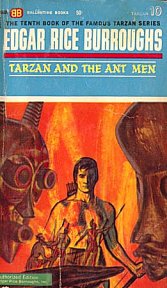 As the Ant Men were only eighteen inches tall and Tarzan had been four
times their height one might wonder how he could be kept enslaved.
Quite simply through the genius of the Walmak, Zoanthrohago, of the Veltops.
The Big Guy was shrunk to eighteen inches. However, and this will
be important, he has retained all his former strength. Thus he is
four times stronger than any of the Ant Men. This is one of the details
that I think probably relates to Einstein's Relativity. When John
Carter went to Mars he was no stronger than he had been but gravity on
Mars is relatively much less than on Earth so he had the appearance of
greater strength. With Tarzan here, Earth's gravity remains the same
but Tarzan's strength relative to his size is four times greater.
Thus like Carter on Mars Tarzan can jump to incredible heights. He
takes a standing leap from the floor well through an opening in the ceiling.
He actually tears the head off an Ant Man with his bare hands. Burroughs
is carefully manipulating relativity.
As the Ant Men were only eighteen inches tall and Tarzan had been four
times their height one might wonder how he could be kept enslaved.
Quite simply through the genius of the Walmak, Zoanthrohago, of the Veltops.
The Big Guy was shrunk to eighteen inches. However, and this will
be important, he has retained all his former strength. Thus he is
four times stronger than any of the Ant Men. This is one of the details
that I think probably relates to Einstein's Relativity. When John
Carter went to Mars he was no stronger than he had been but gravity on
Mars is relatively much less than on Earth so he had the appearance of
greater strength. With Tarzan here, Earth's gravity remains the same
but Tarzan's strength relative to his size is four times greater.
Thus like Carter on Mars Tarzan can jump to incredible heights. He
takes a standing leap from the floor well through an opening in the ceiling.
He actually tears the head off an Ant Man with his bare hands. Burroughs
is carefully manipulating relativity.
Even though he had been four times
taller than the Ant Men his lack of comprehension is such that he can't
imagine how the Ant Men became as tall as he is. His friend the Prince
Adendrohakis, who was captured at the same time as he was has to explain
that the Ant Men weren't taller but that he was shorter. Yeah!
Imagine that.
Tarzan has a hard time doing
so but his friend explains how.
Here we are introduced to the
prototype of the Great Ras Thavas, The Mastermind Of Mars.
I am indebted here to the ERB
scholar Vishwas Gaitonde, who wrote in the Burroughs
Bulletin, for putting me solidly on the thread of ERB's fascination
with creating or altering life. Gaitonde wrote some very exciting
essays for BB. If he's out there he should submit some to the ERBzine.
Of course, ERB mentions Frankenstein
at least a couple times in the corpus. Once again this book that
was very influential on him is not found in his library. One wonders
why he never purchased a copy or perhaps hundreds of titles are missing.
Mary Shelley's story must have
entranced his mind. Thus his eighth story published is The
Monster Men which deals with the creation of life. Dr. Case
must himself have been an early version of Ras Thavas. Case was about
as successful as the Great Ras whose creative efforts go haywire in The
Synthetic Men Of Mars. Just before that effort 'God' in Tarzan
And The Lion Man makes a mess of things in his efforts.
Zoanthrohago is closer to 'God'
than Case and Ras as he isn't trying to create life so much as to manipulate
the end result. Zoan has it in mind to discover a process by which
to enlarge a division of Ant Men who will be able finally to subdue all
the various cities in Minunia. This guy is no Ras Thavas but no slouch
either. I'm surprised Stalin didn't put his scientists to work to
create troops who could step over tanks to help with the ape men his boys
were working on.
Unable to enlarge men Zoan has
discovered a way to reduce them. How do you suppose he does this?
C'mon now, this you could have guessed. Think back to 1899 in Toronto.
Yeah, right. You hit them on the forehead.
Now, when the Veltops attacked
the Trohans Tarzan was in the van. First he heard the Veltops coming
by pressing his ear to the ground spoiling their surprise attack then in
some dim witted notion, the Big Bwana makes some surprising goofs after
he breaks a bough from a tree to sweep the invaders away. He fails
to fall back with the Trohans. Surrounded he is knocked down by the
bounding antelopes. He loses consciousness but doesn't know how.
Once again we have a reenactment of 1899.
Tarzan loses consciousness at
about the same time Miranda, his double, is bashed. The awakenings
of Esteban and Tarzan coincide. In fact they wake up on opposite
pages of two adjoining chapters. Therefore both are related to Toronto.
Miranda wakes up with addled brains while Tarzan wakes up one fourth his
size. Figure that one out. Alice in Wonderland stuff.
Zoanthrohago, the leading scientist
of his age was in the van of the invaders. It was he who knocked
Tarzan down rendering him unconscious in some 'mysterious' way. Obviously
he bopped the Big Bwana on the forehead as that was the method of reduction.
So, we have a miniature Tarzan,
a slave, working at the mill in Gaza, so to speak. He is sent to
the quarries. However the king, Elkomoenhago wishes to see him.
Tarzan and the Prince, acting as interpreter as Tarzan is supposed to speak
an unknown language, are taken to the laboratory of Zoan.
Of course Tarzan can understand
every word. Zoan goes into a dissertation on his process. Tarzan
learns that his shrinkage is not permanent as the process is imperfect
and that he may return to his former size at any time. As he is on
the top floor or the royal dome of the Veltops this begins to cause him
some anxiety.
Zoan then gives a demonstration
of his process on a mouse. For those who don't think Burroughs knew
anything of Esoterica or Theosophy this should enlighten them. I'm
not real clear on this nor have I worked out the arithmetic but it involves
multiples of seven and materials made of the seven different metals.
All those sevens and the seven different metals indicate ERB has been reading
something off there in the Occult.
Elko suggests that if hitting
in the forehead makes one smaller then hitting in the back of the head
should make one larger. You see, one side makes you larger, one side
makes you smaller. It works with mushrooms. Zoan didn't laugh
out loud but he might as well have.
While Zoanthrohago is the mastermind
of Veltopismakus he incurs the jealous displeasure of Elko right after
this demonstration from which he is escorted to the dungeons.
So Burroughs combines his science
with a form of the esoteric.
3.
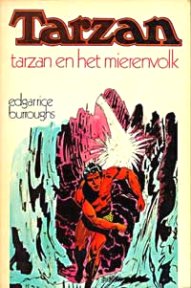 In many ways the Great War running from 1914-18 masked the end of nineteenth
century ways and the emergence of twentieth century ways. While Women's
Suffrage, what had been known as the Temperance Movement and the Income
Tax had been developing for decades they seemed to become a concrete reality
just after the war ended ushering in a world with a completely different
appearance and newer, faster tempo. It really was a New Era when
the twenties came into existence. Just evolution of society really,
but the transition was sharp.
In many ways the Great War running from 1914-18 masked the end of nineteenth
century ways and the emergence of twentieth century ways. While Women's
Suffrage, what had been known as the Temperance Movement and the Income
Tax had been developing for decades they seemed to become a concrete reality
just after the war ended ushering in a world with a completely different
appearance and newer, faster tempo. It really was a New Era when
the twenties came into existence. Just evolution of society really,
but the transition was sharp.
Burroughs was forty-five years
old in 1920. The time was one of the exciting ones when everything
you know is wrong. Whatever worked yesterday doesn't work today.
It's a new paradigm, a brand new way of looking at things. You go
to sleep in one world and it's a new world when you wake up in the morning.
Isn't that exactly what happened to Tarzan? Thus Burroughs had some
new puzzlements to deal with. Specifically they were the Sixteenth,
Eighteenth and Nineteenth Amendments to the Constitution.
The Sixteenth brought the income
tax into existence, the Eighteenth took legal booze out of existence and
the Nineteenth which gave women the vote changed the whole structure of
society. The first story about the Alalus dwelt on the Nineteenth
Amendment quite extensively. The Income Tax and Prohibition, as Temperance
was now known, came in for a full treatment in this tale.
This book was written as the
Harding Administration ended. Harding himself died under mysterious
circumstances in August of 1923 just after ERB began this story.
While I personally think Harding was a much better President than most
evaluations there can be no question that he didn't keep close tabs on
the shenanigans of his associates. On the other hand we must remember
that the period following the War was one of unparalleled lawlessness.
Even if some of Harding's associates were corrupt they were more honest
than society at large. Shall we say the people got the administration
they deserved. Take a lesson. Harding's Postmaster General,
Will Hays, was able to bring the endemic mail robberies under control establishing
order there. That he was then coopted by Hollywood should tell us
something of what was going on.
The so-called Tea Pot Dome oil
scandal is blown completely out of proportion.
However Harding's crony, Harry
Daugherty, may be represented by Vestako, an advisor of Elko, who extracted
so many slaves from the other members of Elko's 'cabinet' in exchange for
silence.
The Sixteenth Amendment itself
was passed during the administration of Republican William Howard Taft.
The Amendment was first proposed on February 25, 1913 just before Woodrow
Wilson and the Democrats assumed the reins of government.
Rates were still very moderate
at the time ERB was complaining. They would remain so during the
Coolidge and Hoover administrations. The tax would become a tool
of expropriation in the hands of Franklin Delano Roosevelt and the 'Democrats.'
The criminal expropriatory rates would balloon during the thirties reaching
90% in the forties. As an expropriatory tool of the 'masses' against
the 'capitalists' there were no consistent rules that could be followed
by the taxpayer, nor were the rules published. What was supposedly
valid one day would be disallowed the next. ERB's complaints in 1920
became really valid under FDR. Nevertheless ERB goes on like this,
p. 139:
"It is seldom," (the publican) said, "that warriors rich enough to possess
gold come to our poor shop. Pieces of iron and bits of lead, with
much wooden money, pass into my coffers; but rarely do I see gold.
Once I did, and many of my customers were formerly of the richest of the
city. Yonder see that tall man with the heavily wrinkled face.
Once he was rich-- the richest warrior in his dome. Look at him now!
And see there in the next room performing menial services, men who once
owned slaves so prosperous that they in turn, hired other slaves to do
the meaner duties for them. Victims, all of them, of the tax that
Elkomoelhago has placed upon industry.
"To be
poor," he continued, "assures one an easier life than being rich, for the
poor have no tax to pay, while those who work hard and accumulate property
have only their labor for their effort, since the government takes all
from them in taxes.
"Over
there is a man who was very rich. He worked hard all his life and
accumulated a vast fortune. For several years after Elkomoelhago's
new tax law was enforced, he struggled to earn enough to ensure that his
income would be at least equal to his taxes and his cost of living; but
he found that it was impossible.
A few years later William Randolph
Hearst, a critic of FDR, would find himself in just that situation.
Probably ERB needed those taxes to help him out of the financial hole he
was digging for himself. As a boy of the old pre-income tax school
he found the tax frustrating. The times can change but why should
they change that way, eh?
The Eighteenth Amendment prohibiting
the use of alcohol he found not so much frustrating as incomprehensible.
Indeed the insanity of the law is such that one wonders how otherwise reasonable
people would have thought it could have been effective. The extensive
criminality that developed from it had already found expression in ERB's
writing in 1922's Girl
From Hollywood.
Here, as he and Trohan are escaping
from the royal dome they enter a storeroom in which confiscated alcohol
is kept. The men guarding it are all stone drunk. The storeroom
may reflect the fully stocked concealed cellar that came with Tarzana when
ERB bought it.
4.
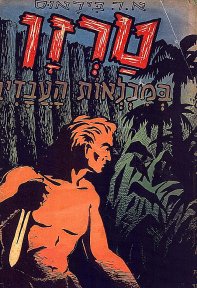 The Minunians seems to be singularly free of religion. ERB has nothing
to say of their religious practices. He seems rather to insist on
the godlike quality of Tarzan. He expresses this in Tarzan's
refusal to consider himself a 'victim.' Burroughs accepts difficulties
as part of the process of life. His characters survive difficulties
most of us never see. They are, for instance enslaved time and time
again. Yet, they never succumb to victimhood as Trohan is willing
to do. John Carter's motto is 'I still live.' Thus neither
Carter, Tarzan or any other heroic character become bitter or sour.
They never whimper or cry. They are self-sufficient.
The Minunians seems to be singularly free of religion. ERB has nothing
to say of their religious practices. He seems rather to insist on
the godlike quality of Tarzan. He expresses this in Tarzan's
refusal to consider himself a 'victim.' Burroughs accepts difficulties
as part of the process of life. His characters survive difficulties
most of us never see. They are, for instance enslaved time and time
again. Yet, they never succumb to victimhood as Trohan is willing
to do. John Carter's motto is 'I still live.' Thus neither
Carter, Tarzan or any other heroic character become bitter or sour.
They never whimper or cry. They are self-sufficient.
While I wasn't conscious of this
quality as a kid when I first read this stuff I'm sure it attracted me
then as it is that something of value I received from Tarzan then and cherish
now.
I am sure that it is this quality
of manhood and independence that the masters of victimhood so resent in
Burroughs that they still carry on a vendetta against him. Fellows
like Richard Slotkin and his kin who set up monuments to victimhood and
then defame anyone who won't bow down to these citadels of death.
I live. I live until I die and when I die I want no monuments set
up for my death. I live and I want my memory to live and I won't
worship death. Let those who will do but don't defame me because
I reject their cult of death.
Thus Trohan keeps telling Tarzan
that there is no way to escape, that they must remain victims until they
die. Tarzan says he will escape. Trohan says he doesn't believe
it. Now, this is interesting, Tarzan accuses Trohan of having no
faith in him. Appropriate for a god but a little over the top for
a mere mortal. Set back on his heels Trohan says he does have faith
in Tarzan. So they go about escaping. What was that Frankie
Boy sings? 'I did it my way?'
So, yes, I too had faith in Tarzan.
I, too, believed that whatever it was, could be done. I didn't have
to be a victim. Whatever knocks life gave me and I've had my share,
I could overcome them.
I heard a little piece of ephemera
I'm sure no one remembers anymore by Freddie Hart- does anyone even remember
him?- that I took to heart:
Now, there stands a blind man,
A man that can't see.
He's not complaining,
Why should you or me.
Don't tell me your troubles,
I've got enough of my own.
Be thankful you're livin'
Drink up and go home.
~ Freddie Hart
Alright. Enough of that. Let those who would be victims be
victims and leave the rest of us alone.
5.
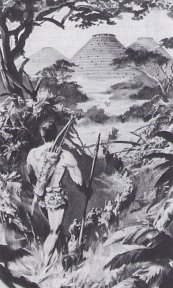 One hears that Burroughs was a formula writer. All literature posits
a problem or problems that have to be solved. The problem has
to be presented to the reader. The question is not whether one follows
a method for presenting the problem, or in other words a formula for doing
so but the variety of detail in doing it. Burroughs borrows his method
or formula from H. Rider Haggard. If one ignores the details all
Haggard novels can be said to be the same, follow a formula, as with Burroughs.
The kicker is that both Haggard and Burroughs know that they have a method,
varying the details in clever and imaginative ways. I've read most
of Haggard at least once and all of Burroughs two or more times.
I know what to expect in their manner of presentation but the execution
of the formula is always breathtaking. While one criticizes this
or that I find no real fault in either writer. Either you like them
or you don't. I like Haggard a lot and have reverence for Burroughs'
Tarzan novels.
One hears that Burroughs was a formula writer. All literature posits
a problem or problems that have to be solved. The problem has
to be presented to the reader. The question is not whether one follows
a method for presenting the problem, or in other words a formula for doing
so but the variety of detail in doing it. Burroughs borrows his method
or formula from H. Rider Haggard. If one ignores the details all
Haggard novels can be said to be the same, follow a formula, as with Burroughs.
The kicker is that both Haggard and Burroughs know that they have a method,
varying the details in clever and imaginative ways. I've read most
of Haggard at least once and all of Burroughs two or more times.
I know what to expect in their manner of presentation but the execution
of the formula is always breathtaking. While one criticizes this
or that I find no real fault in either writer. Either you like them
or you don't. I like Haggard a lot and have reverence for Burroughs'
Tarzan novels.
Tarzan is indomitable.
One almost believes the Big Bwana is reciting W.E. Henley's Invictus as
he roils through his adventurous life.
Invictus
W.E. Henley 1849-1903
Out of the night that covers me,
Black as the Pit from pole to pole,
I thank whatever gods may be
For my unconquerable soul.
In the fell clutch of circumstance
I have not winced nor cried aloud.
Under the bludgeonings of chance
My head is bloody but unbowed.
(Boy, do those two lines have meaning for ERB and
Tarzan)
Beyond this place of wrath and tears
Looms but the Horror of the shade,
And yet the menace of the years
Finds, and shall find me, unafraid.
It matters not how strait the gate,
How charged with punishments the scroll,
I am the master of my fate.
I am the captain of my soul.
And more, much more than this,
I did it my way. (Paul Anka) Well, maybe not his way but ERB rose
above a cruel fate that had consigned him to the bottom of the heap and
if Tarzan doesn't do it his way he doesn't do it anyone else's way either.
If one reads Invictus carefully
and with feeling one finds the central meaning of the Tarzan series and
ERB over all clearly expressed. The point itself could be epitomized
in John Carter's slogan - I still live. The poem also expresses ERB's
concern with the soul. The Monster Men revolves on the problem
of the soul; the Bolgani of The Valley Of Diamonds are said to have the
souls of men. One imagines then that the line: I am the captain
of my soul- is charged with special meaning for Burroughs. Nor do
I think there can be any question that ERB read Invictus. This is
perhaps as famous a poem as can be found in the English language.
I don't know that ERB had it committed to memory but I wouldn't doubt it.
So, in this story ERB follows
the Haggard formula to a T. After a series of minor skirmishes he
sets Tarzan the problem of delivering himself from slavery. In Minunia
delivering himself would be too easy so he also delivers his friend Prince
Trohanadalmakus and the hidden princess, the slave girl Talaskar.
Not only that but he has to descend once again into the lowest level of
the slave quarries to get her. To hell and back twice.
While the story casually read
comes across as some lightweight pulp adventure novel Burroughs has actually
set himself a formidable task.
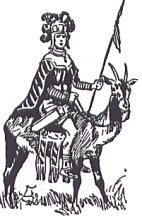 The details of military maneuvers, diadets and the building of the great
hives housing thousands of Minunians, as the Ant People are collectively
known is quite fascinating. Now, all this is done in just over a
hundred pages so Burroughs leaves no breathing space for the reader.
As a kid I was panting from start to finish. I had no trouble visualizing
all this stuff so I was literally living the story alongside Tarzan and
Trohan. There are those who say Burroughs is not a good writer but
no writer can do more than involve the reader completely in his story.
I was involved then while I can immerse myself today.
The details of military maneuvers, diadets and the building of the great
hives housing thousands of Minunians, as the Ant People are collectively
known is quite fascinating. Now, all this is done in just over a
hundred pages so Burroughs leaves no breathing space for the reader.
As a kid I was panting from start to finish. I had no trouble visualizing
all this stuff so I was literally living the story alongside Tarzan and
Trohan. There are those who say Burroughs is not a good writer but
no writer can do more than involve the reader completely in his story.
I was involved then while I can immerse myself today.
I'm not aware that there were
glaciers in Africa, perhaps Burroughs was merely showing off the geological
knowledge he acquired at the MMA, but the Minunian cities are built on
a terminal moraine hence there are lots of stones for building materials.
The stones are mined by slaves
captured in war. Incredibly in this brief novella Burroughs creates
a whole organization of society including the institution of slavery.
Slaves with green tunics are first generation slaves who have no hope of
changing their status. Their offspring become white tunicked slaves
who live above ground and have the chance of intermarrying with the freemen.
ERB takes only a few lines to
tell this fairly complicated organization. It is necessary for the
reader to know it because after an idyll of a few weeks Tarzan is captured
in the Veltopismakusian attack and consigned to the quarries as a
green tunicked slave. He is not only consigned to the quarries but
taken to the bottommost level, thirty-six levels and hundreds of feet down.
Tarzan is literally buried alive. The night that covers him is the
Pit. He has nothing but his will and his unconquerable soul to deliver
him from this dark, dark night. Of course it doesn't hurt to have
four times normal strength and an unbroken string of incredible luck.
But then, as the saying goes- luck favors the prepared mind and Tarzan's
is prepared to make his breaks as well as take advantage of them.
In the quarries he finds his
friend Trohan who was captured at the same time and a gorgeous 'cook' Talaskar.
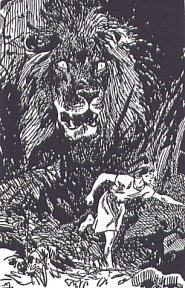 Tarzan is no ordinary Minunian although he has been reduced in size from
6'0" to the average Minunian height of 18". He is a slave of the
scientist or Walmak, as they are known in Minunia. A Walmak translates
as a man who can work miracles through science. The Minunians who
have never seen his like assume that he is an Alalus. As Tarzan,
like any other sullen beast, had never spoken this turns out to be an asset.
Trohan pretends that he speaks a strange language that is Tarzan's.
He appoints himself an interpreter even though Tarzan can understand and
speak the universal Minunian language.
Tarzan is no ordinary Minunian although he has been reduced in size from
6'0" to the average Minunian height of 18". He is a slave of the
scientist or Walmak, as they are known in Minunia. A Walmak translates
as a man who can work miracles through science. The Minunians who
have never seen his like assume that he is an Alalus. As Tarzan,
like any other sullen beast, had never spoken this turns out to be an asset.
Trohan pretends that he speaks a strange language that is Tarzan's.
He appoints himself an interpreter even though Tarzan can understand and
speak the universal Minunian language.
Thus when Zoan and Elko have
him brought up to the royal dome for examination Trohan goes along.
At this point Tarzan learns that he may regain his original stature at
any time.
The two men are placed in a holding
room before being transferred back to the quarries on the morrow.
As Tarzan realizes that 'beyond this place of wrath and tears looms but
the Horror of the shade' he sets to work to escape. Of course,
Trohan says that escape is impossible so why even try. Well, 'in
the fell clutch of circumstance (Tarzan) has not winced or cried aloud'
he simply asks if Trohan has faith in him. Trohan has faith so they
set to work. As the Irish say, the wind was at their backs all the
way. They manage to descend from the top of the dome to street level
while still getting a good night's sleep, a hearty breakfast and a lecture
on the income tax.
Now comes the hard part.
They have to reenter the quarries, descend to the lowest level for Talaskar
and escape again. Here the Great One's character really shines.
Boy, as a kid this one really got me. Trohan figures 'What the heck,
we're out, let's slide out of town. Forget the girl.' But no,
Tarzan remembers the kindness of a stranger and says he's going back for
Talaskar whether Trohan comes or not. What kind of guy would walk out on
his best friend? Trohan sighs and goes along.
In the interim the Vental- a
Vental is the Lieutenant of an ental, has bought Talaskar and taken her
to his quarters. This guy is a bad one. Undaunted Tarzan and
Trohan find the Vental's quarters where he has Talaskar but they are recognized
by Caraftap, a slave snitch who informs the Vental in his quarters.
By this time the alarm is out
and the three slaves, the Vental and Caraftap are trapped in the Vental's
quarters. With extreme brutality, even for Burroughs, Tarzan barehandedly
tears the head off Caraftap then dispatches the Vental.
Now, this is all pretty exciting
if you don't stop to examine details. The passageway runs through
the chambers with locked doors at either end. There appears to be
no way out. But, looking up Tarzan notes an opening in the ceiling.
Why it's there is anybody's guess especially as it must have been twice
the size of a manhole.
Remember, although Tarzan is
reduced to a fourth, Tarzan has the strength of four. From a standing
jump he soars through the opening pulling Talaskar and Trohan after him
. Their pursuers apparently don't look up.or notice this gaping hole
or else they're so familiar with it they ignore it.
Tarzan does find a way out.
He has to crawl on his belly in the night that covers him through a very
narrow aperture before he enters a cavity where a tall man can sit up.
Midgets apparently can walk erect. It's still pitch dark. For
me this would be a harrowing experience. Such situations as this
prevented me from being a spelunker.
Calling his companions to him
they can now light a candle without fear of discovery. I don't think
I've mentioned it before but these candles are marvelous, they make the
radium lights of Mars look like child's play. The whole Minunian
civilization is dependent on them. Some early Walmak discovered
a way to reverse the usual process so that instead of consuming oxygen
the candles release oxygen providing fresh air in these tightly enclosed
places. Pretty nifty.
The three follow the passageway
which gradually widens until they enter a chamber. As they look around
they discover a number of shadowy bodies lining the walls. Dead men.
This used to be some powerful person's private prison. Tarzan touched
one and it crumbles to dust. Always the scariest part of any movie.
'Been here a while.' Tarzan opines.
'Not necessarily so.' Trohan
replies. It seems until recently the Minunians had let ants scavenge
their dead. Dead or alive, what's that to an ant, right? In
the ensuing war the ants were wiped out. Nice little dissertation
on how to go about it too.So these lumps could have been hollowed out by
the ants fairly recently.
But wait, Tarzan hears a voice
on the other side of a panel they discover. On the other side is
Elko's daughter who naturally has a big crush on Tarzan who she has seen.
She brazenly puts it to him while
he modestly declines. Maneuvered over a trap door Tarzan slips to
near certain death at the fangs of two cats waiting in a cell below.
Ensues the usual comedy of errors.
Zoan has been arrested by Elko
and placed in a cell adjacent to the cats. The door between isn't
locked so he draws Tarzan inside. Meanwhile, a floor or so above,
the Princess is wrestling with Talaskar who she thinks is her rival for
Tarzan, down into the Pit they go. Trohan left alone does the right thing
leaping into the Pit.
Well the rest is all pretty straight
forward adventure writing, they combine forces and escape, finding refuge
in Trohan's city. As usual with Burroughs Trohan wants to marry the
slave girl. The king waives any rules, customs and traditions which
was unnecessary as Talaskar is actually a Princess of Mandalamakus.
Mandala-makus. For those who don't find a Theosophical connection
a mandala is a mystic symbol. So, it's almost magic.
Tarzan thinks its time to go
home so the Minunians turn him over to the Alalus lad who conducts him
to the inside wall of the Great Thorn Forest. Being small Tarzan
has no difficulty walking through this huge natural boma. Recognizing
the nausea that seizes him at the outer edge as his return to normal size
he makes it into the grass on the other side.
6.
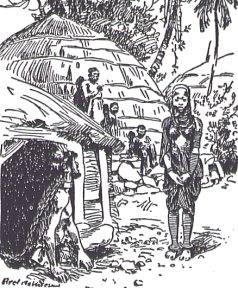 Just as Tarzan and Miranda lost consciousness and recovered it at the same
time earlier so now their careers act in unison but with different agents
reversing their positions. This is clever.
Just as Tarzan and Miranda lost consciousness and recovered it at the same
time earlier so now their careers act in unison but with different agents
reversing their positions. This is clever.
Usulu, as mentioned before, finds
Miranda feeding on the rotting buffalo carcass. Miranda looked like
Tarzan but as there were two lookalikes roaming the jungle their might
have been some doubt in Jane's mind as to whether Usulu conducted Tarzan
or Miranda home.
ERB has brilliantly prepared
for this exigency.
It will be remembered that Tarzan
always wore the diamond encrusted gold locket with his parents pictures
around his neck.
Back in Alalusland at the beginning
of these three stories when Tarzan was unconscious in the First Woman's
quarters a boy stole the locket from him. The boy was subsequently
killed. When Ska the vulture fed on the boy the locket double looped
around its neck. When Ska descended on this same buffalo carcass
Esteban is feeding on the locket caught on the horn of the dead buffalo.
A lion approached, Ska tried to fly away but connected to the buffalo by
the locket she became meat for the lion. The locket is there on the
horn.
Usulu recognizing the locket
as Tarzan's places it around Miranda's neck. Thus when Esteban is
led into Jane's presence the locket is proof that this is the real Tarzan.
Rather nicely done, I thought.
As Esteban was laying in the
grass, so to speak, so a few miles away Tarzan duplicates the scene as
he recovers from his expansion. The witch doctor, Khamis, happens
along duplicating Usulu, in this case capturing Tarzan and imprisoning
him in Obebe's village. Thus Burroughs neatly links the fates of
the Tarzan twins- Tarzan and Miranda- reuniting them once again in Tarzan's
living room. Both personalities in the split recombine into one,
one presumes, as Burroughs leaves the issue hanging in the air..
As mentioned, in Tarzan And The Lion Man his double will be carried
off by a fever. The first fever I can recall being mentioned in the
series although Africa is the land of fevers.
7.
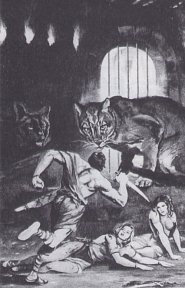 In forming these problems ERB may have resolved them in his mind while
having thus written himself out on Tarzan. In any event there is
a four year hiatus between this novel and the next, Tarzan, Lord Of
The Jungle.
In forming these problems ERB may have resolved them in his mind while
having thus written himself out on Tarzan. In any event there is
a four year hiatus between this novel and the next, Tarzan, Lord Of
The Jungle.
I organize the oeuvre into four
sets of novels for my convenience. The first four-- Tarzan Of
The Apes, The Return Of Tarzan, Beasts Of Tarzan and The
Son Of Tarzan I group as The Russian Quartet because they are held
together by the feud between Rokoff, Paulvitch and Tarzan. I am of
the opinion that Rokoff and Paulvitch represent Frank Martin and R.H. Patchin
who carried on a vendetta against Burroughs because he took Emma from Martin.
I think research will prove this.
The next seven novels from Jewels
Of Opar
through
Lord Of The Jungle I call the Jungle Idyll just
to give them a name. The following nine beginning with Lost Empire
and ending with Tarzan's Quest I call Political Undertones because of the
feud between the Left and ERB.
Tarzan The Magnificent, the
two novels unpublished during his lifetime and Foreign Legion I bunch as
the Final Four. So, while the Jungle Idyll is complete with this
diptych, Golden Lion - Ant Men Lord Of the Jungle gets tacked on
as a coda. Written in 1927 Lord Of The Jungle was written
after ERB began his affair with Florence Gilbert. Thus the succeeding
nine novels might also easily be called the Adultery novels as equally
with politics they concern ERB, Emma and Florence.
The tone of the future novels
then changes a great deal. ERB begins to address a new set of problems
largely setting aside these earlier ones.
Time also passes. Just as the
few novels written between 1918 and 1923 reflect a different world than
ERB had known as a young man so the thirties washed out the twenties.
Time may give us all the time we need or can use as ERB states in Tarzan
The Invincible but all that time may be more tumultuous than we desire.
Appendix
To The Diptych
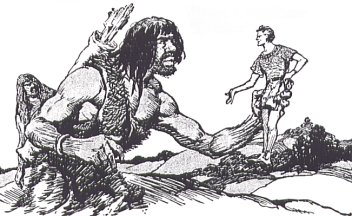
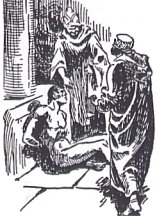
The unanswered question is when
did the notion of Tarzan form in Burroughs' mind? I think we have
the clue to the beginning of the genesis presented in Golden Lion
and Ant Men.
As is well known the fictional
Tarzan was given birth in 1888. Now, the Old Man in Golden Lion
was a stowaway on the ship that brought Henry Morton Stanley to Africa
for the 1888-89 relief expedition for Emin Pasha. Stanley wrote his
account of his adventures on the expedition in Egypt immediately after.
Incredibly his thousand page account- In
Darkest Africa- was written in thirty days being published shortly
thereafter.
In 1888-89 ERB was from 13 to
16 years old. That is to say that he was aware. He surely followed
the exciting story in the newspapers as the dispatches came in. The
expedition may have been the last great adventure story of the nineteenth
century while it has never been topped since.
We know that Stanley made an
indelible impression on the boy as, why not? While Stanley is disparaged
today by the Liberal crowd for his derring-do Stanley's story is one of
the greatest, if not the greatest, adventure story of all time. I
respect the guy.
Stanley came to represent
Africa for the world and for both the young and mature Edgar Rice Burroughs.
In his last Tarzan novel published in his lifetime, save Tarzan And
The Foreign Legion which is outside the psychological continuum, ERB
states explicitly that Tarzan has replaced Stanley as the symbol of Africa.
Tarzan in his mind was in competition with Stanley as the avatar of the
Dark Continent.
My suggestion then is that Stanley
and Tarzan stand to each other as do Miranda and Tarzan. Further
that the reason Tarzan was born in 1888 is that that was the year ERB had
his mind blown by the fantastic adventure of Stanley up the Aruwimi.
That is why so much of the oeuvre takes place in and around the Ituri Rain
Forest.
So, I believe Tarzan was born
in Burroughs mind in 1888 from the exploits of Stanley although many other
elements went into the development of the Big Bwana.
When questioned Burroughs either
wouldn't or couldn't say exactly how the idea of Tarzan was born.
The dating of 1888 for his birth is however a dead giveaway.
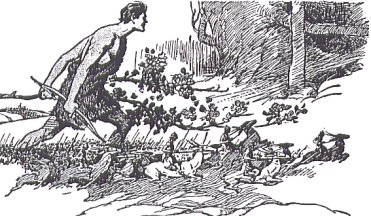

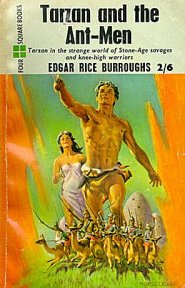
 The Ant people are a very militaristic people always prepared for war.
Their military bearing and ardor when Tarzan first encounters them battling
an Alalus woman attracts him to them. As he removes the Alalus woman
from the battle the Ant Men accept him as a comrade in arms. Having
no particular love for the Alalus lad Tarzan abandons him loping off after
the Ant Men.
The Ant people are a very militaristic people always prepared for war.
Their military bearing and ardor when Tarzan first encounters them battling
an Alalus woman attracts him to them. As he removes the Alalus woman
from the battle the Ant Men accept him as a comrade in arms. Having
no particular love for the Alalus lad Tarzan abandons him loping off after
the Ant Men.
 As the Ant Men were only eighteen inches tall and Tarzan had been four
times their height one might wonder how he could be kept enslaved.
Quite simply through the genius of the Walmak, Zoanthrohago, of the Veltops.
The Big Guy was shrunk to eighteen inches. However, and this will
be important, he has retained all his former strength. Thus he is
four times stronger than any of the Ant Men. This is one of the details
that I think probably relates to Einstein's Relativity. When John
Carter went to Mars he was no stronger than he had been but gravity on
Mars is relatively much less than on Earth so he had the appearance of
greater strength. With Tarzan here, Earth's gravity remains the same
but Tarzan's strength relative to his size is four times greater.
Thus like Carter on Mars Tarzan can jump to incredible heights. He
takes a standing leap from the floor well through an opening in the ceiling.
He actually tears the head off an Ant Man with his bare hands. Burroughs
is carefully manipulating relativity.
As the Ant Men were only eighteen inches tall and Tarzan had been four
times their height one might wonder how he could be kept enslaved.
Quite simply through the genius of the Walmak, Zoanthrohago, of the Veltops.
The Big Guy was shrunk to eighteen inches. However, and this will
be important, he has retained all his former strength. Thus he is
four times stronger than any of the Ant Men. This is one of the details
that I think probably relates to Einstein's Relativity. When John
Carter went to Mars he was no stronger than he had been but gravity on
Mars is relatively much less than on Earth so he had the appearance of
greater strength. With Tarzan here, Earth's gravity remains the same
but Tarzan's strength relative to his size is four times greater.
Thus like Carter on Mars Tarzan can jump to incredible heights. He
takes a standing leap from the floor well through an opening in the ceiling.
He actually tears the head off an Ant Man with his bare hands. Burroughs
is carefully manipulating relativity.
 In many ways the Great War running from 1914-18 masked the end of nineteenth
century ways and the emergence of twentieth century ways. While Women's
Suffrage, what had been known as the Temperance Movement and the Income
Tax had been developing for decades they seemed to become a concrete reality
just after the war ended ushering in a world with a completely different
appearance and newer, faster tempo. It really was a New Era when
the twenties came into existence. Just evolution of society really,
but the transition was sharp.
In many ways the Great War running from 1914-18 masked the end of nineteenth
century ways and the emergence of twentieth century ways. While Women's
Suffrage, what had been known as the Temperance Movement and the Income
Tax had been developing for decades they seemed to become a concrete reality
just after the war ended ushering in a world with a completely different
appearance and newer, faster tempo. It really was a New Era when
the twenties came into existence. Just evolution of society really,
but the transition was sharp.
 The Minunians seems to be singularly free of religion. ERB has nothing
to say of their religious practices. He seems rather to insist on
the godlike quality of Tarzan. He expresses this in Tarzan's
refusal to consider himself a 'victim.' Burroughs accepts difficulties
as part of the process of life. His characters survive difficulties
most of us never see. They are, for instance enslaved time and time
again. Yet, they never succumb to victimhood as Trohan is willing
to do. John Carter's motto is 'I still live.' Thus neither
Carter, Tarzan or any other heroic character become bitter or sour.
They never whimper or cry. They are self-sufficient.
The Minunians seems to be singularly free of religion. ERB has nothing
to say of their religious practices. He seems rather to insist on
the godlike quality of Tarzan. He expresses this in Tarzan's
refusal to consider himself a 'victim.' Burroughs accepts difficulties
as part of the process of life. His characters survive difficulties
most of us never see. They are, for instance enslaved time and time
again. Yet, they never succumb to victimhood as Trohan is willing
to do. John Carter's motto is 'I still live.' Thus neither
Carter, Tarzan or any other heroic character become bitter or sour.
They never whimper or cry. They are self-sufficient.
 One hears that Burroughs was a formula writer. All literature posits
a problem or problems that have to be solved. The problem has
to be presented to the reader. The question is not whether one follows
a method for presenting the problem, or in other words a formula for doing
so but the variety of detail in doing it. Burroughs borrows his method
or formula from H. Rider Haggard. If one ignores the details all
Haggard novels can be said to be the same, follow a formula, as with Burroughs.
The kicker is that both Haggard and Burroughs know that they have a method,
varying the details in clever and imaginative ways. I've read most
of Haggard at least once and all of Burroughs two or more times.
I know what to expect in their manner of presentation but the execution
of the formula is always breathtaking. While one criticizes this
or that I find no real fault in either writer. Either you like them
or you don't. I like Haggard a lot and have reverence for Burroughs'
Tarzan novels.
One hears that Burroughs was a formula writer. All literature posits
a problem or problems that have to be solved. The problem has
to be presented to the reader. The question is not whether one follows
a method for presenting the problem, or in other words a formula for doing
so but the variety of detail in doing it. Burroughs borrows his method
or formula from H. Rider Haggard. If one ignores the details all
Haggard novels can be said to be the same, follow a formula, as with Burroughs.
The kicker is that both Haggard and Burroughs know that they have a method,
varying the details in clever and imaginative ways. I've read most
of Haggard at least once and all of Burroughs two or more times.
I know what to expect in their manner of presentation but the execution
of the formula is always breathtaking. While one criticizes this
or that I find no real fault in either writer. Either you like them
or you don't. I like Haggard a lot and have reverence for Burroughs'
Tarzan novels.
 The details of military maneuvers, diadets and the building of the great
hives housing thousands of Minunians, as the Ant People are collectively
known is quite fascinating. Now, all this is done in just over a
hundred pages so Burroughs leaves no breathing space for the reader.
As a kid I was panting from start to finish. I had no trouble visualizing
all this stuff so I was literally living the story alongside Tarzan and
Trohan. There are those who say Burroughs is not a good writer but
no writer can do more than involve the reader completely in his story.
I was involved then while I can immerse myself today.
The details of military maneuvers, diadets and the building of the great
hives housing thousands of Minunians, as the Ant People are collectively
known is quite fascinating. Now, all this is done in just over a
hundred pages so Burroughs leaves no breathing space for the reader.
As a kid I was panting from start to finish. I had no trouble visualizing
all this stuff so I was literally living the story alongside Tarzan and
Trohan. There are those who say Burroughs is not a good writer but
no writer can do more than involve the reader completely in his story.
I was involved then while I can immerse myself today.
 Tarzan is no ordinary Minunian although he has been reduced in size from
6'0" to the average Minunian height of 18". He is a slave of the
scientist or Walmak, as they are known in Minunia. A Walmak translates
as a man who can work miracles through science. The Minunians who
have never seen his like assume that he is an Alalus. As Tarzan,
like any other sullen beast, had never spoken this turns out to be an asset.
Trohan pretends that he speaks a strange language that is Tarzan's.
He appoints himself an interpreter even though Tarzan can understand and
speak the universal Minunian language.
Tarzan is no ordinary Minunian although he has been reduced in size from
6'0" to the average Minunian height of 18". He is a slave of the
scientist or Walmak, as they are known in Minunia. A Walmak translates
as a man who can work miracles through science. The Minunians who
have never seen his like assume that he is an Alalus. As Tarzan,
like any other sullen beast, had never spoken this turns out to be an asset.
Trohan pretends that he speaks a strange language that is Tarzan's.
He appoints himself an interpreter even though Tarzan can understand and
speak the universal Minunian language.
 Just as Tarzan and Miranda lost consciousness and recovered it at the same
time earlier so now their careers act in unison but with different agents
reversing their positions. This is clever.
Just as Tarzan and Miranda lost consciousness and recovered it at the same
time earlier so now their careers act in unison but with different agents
reversing their positions. This is clever.
 In forming these problems ERB may have resolved them in his mind while
having thus written himself out on Tarzan. In any event there is
a four year hiatus between this novel and the next, Tarzan, Lord Of
The Jungle.
In forming these problems ERB may have resolved them in his mind while
having thus written himself out on Tarzan. In any event there is
a four year hiatus between this novel and the next, Tarzan, Lord Of
The Jungle.



